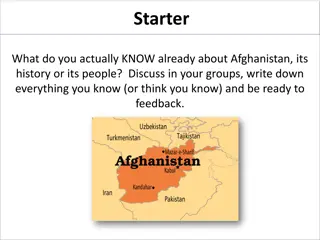
Insights on 'The Kite Runner' Author and Afghanistan's History
Discover background information about Khaled Hosseini, author of 'The Kite Runner', and delve into the history of Afghanistan, including details on the Taliban regime and life before the Soviet invasion. Explore the challenges faced by immigrants in a new country and the difficulties of cultural adaptation.
Download Presentation

Please find below an Image/Link to download the presentation.
The content on the website is provided AS IS for your information and personal use only. It may not be sold, licensed, or shared on other websites without obtaining consent from the author. If you encounter any issues during the download, it is possible that the publisher has removed the file from their server.
You are allowed to download the files provided on this website for personal or commercial use, subject to the condition that they are used lawfully. All files are the property of their respective owners.
The content on the website is provided AS IS for your information and personal use only. It may not be sold, licensed, or shared on other websites without obtaining consent from the author.
E N D
Presentation Transcript
THE KITE RUNNER
Background info on author - The author of "The Kite Runner" is Khaled Hosseini. - He was born on March 4, 1965, in Kabul, Afghanistan. - Hosseini's family immigrated to the United States in 1980, and he has been living in the US since then. - Before becoming a novelist, Hosseini worked as a doctor. - "The Kite Runner" was Hosseini's first novel and was published in 2003, achieving great international success.
The Taliban The Taliban is an extremist Islamic group that emerged in the early 1990s in Afghanistan. Key points about the Taliban and life under their rule: - The Taliban gained control of Afghanistan in 1996 and imposed strict Islamic laws. - Women and girls experienced severe restrictions on their rights, including limited access to education and employment opportunities. - Entertainment such as music, television, and cinema were banned. - The Taliban imposed a harsh interpretation of Sharia law, leading to public executions, amputations, and floggings for various offences. - Non-Muslim minority groups, faced persecution and discrimination.
Life in Afghanistan before the Soviet Invasion: - Prior to the Soviet invasion in 1979, Afghanistan had a monarchy and was relatively stable. - It was a culturally and ethnically diverse country with a mix of different languages and traditions. - Women had more freedom and were able to pursue education and employment without severe restrictions. - The country faced challenges, including political instability and economic disparity, but life for many Afghans was relatively peaceful.
Challenges for immigrants in a new country: -Language barrier: Immigrants often face difficulties communicating and understanding the local language, which can hinder their integration into society. - Cultural differences: Adjusting to a new culture, customs, and societal norms can be challenging and may lead to feelings of isolation and a sense of being an outsider. - Employment opportunities: Immigrants may experience difficulties finding suitable jobs due to language barriers, unfamiliarity with the job market, or lack of recognition of their qualifications. - Discrimination and prejudice: Immigrants may face discrimination based on their ethnicity, religion, or background, which can impact their sense of belonging and overall well-being. - Separation from family and familiar support networks: Being away from their home country means immigrants may not have the same level of support and familiarity they once had, making adjustment to a new country more challenging.
Challenges faced by new immigrants in their new country: - Cultural adaptation and assimilation: Adjusting to a new culture, traditions, and societal expectations can be overwhelming. Immigrants may need to navigate new social norms and assimilate into a different way of life. - Language acquisition: Learning and adapting to a new language is essential for communication, employment opportunities, and overall integration into society. - Finding suitable employment: Immigrants often face obstacles in finding employment that matches their skills and qualifications due to factors such as language barriers, lack of local experience, or discrimination. - Establishing a social network: Building a support system, making new friends, and establishing a sense of belonging in their new community can be challenging for immigrants who may feel isolated and disconnected from their previous networks. - Cultural identity: Balancing their cultural identity from their home country with the need to integrate into a new culture can create a sense of internal conflict and self-discovery for immigrants.





















